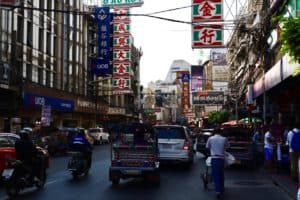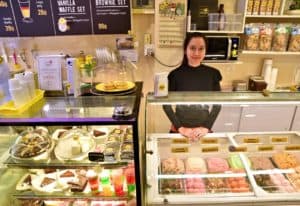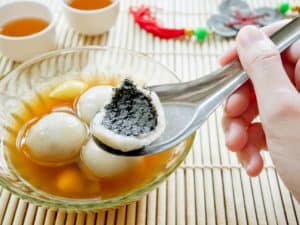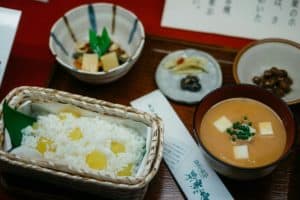Bangkok is a city that never sleeps. It’s a place where you can find food stalls open at all hours, offering a wide range of flavors. From spicy soups to sweet treats, the food scene here is vibrant and diverse. On our Food Tour Bangkok, the entire itinerary is carefully crafted to take you to the best experiences so you can eat like a local and avoid the tourist traps.
One of the best things about Bangkok is its street food culture. You don’t need to spend a lot of money to enjoy delicious meals. Street vendors offer a variety of dishes, each with its own unique taste. You can find everything from noodles and curries to grilled meats and fresh fruits. The aromas from these stalls fill the air, inviting you to explore and try new things.
Exploring Bangkok’s food scene is an adventure in itself. There are always new dishes to discover and flavors to savor. The city’s energy and passion for food are contagious. It’s no wonder that Food Tour Bangkok is so popular. They offer a chance to experience the best of what the city has to offer, guided by local experts who know all the hidden gems.
Bangkok Food Tour: Historical Background
Bangkok, the capital of Thailand, was founded in 1782 by King Rama I, the first monarch of the current Chakri dynasty. The city quickly grew into a major trading hub, thanks to its strategic location along the Chao Phraya River. This river has always been the lifeblood of Bangkok, providing transportation, commerce, and a source of food.
Over the years, Bangkok has seen many changes. The city has expanded rapidly, becoming a bustling metropolis known for its vibrant street life and modern skyscrapers. Despite this growth, Bangkok has managed to preserve its cultural heritage. Temples, palaces, and traditional markets are still integral parts of the city. These landmarks offer a glimpse into Bangkok’s past and its journey to becoming the vibrant city it is today.
Bangkok’s food scene is a reflection of its diverse history. The city’s cuisine has been influenced by various cultures, including Chinese, Indian, and Western traditions. This mix of flavors can be seen in the wide variety of dishes available throughout the city. From spicy curries to sweet desserts, Bangkok offers a culinary experience that is both unique and delicious. The blending of these influences has created a food culture that is rich and diverse.

Thai Sweets and Desserts
Thai sweets and desserts hold a special place in the hearts of locals and visitors alike. These treats are not just about satisfying a sweet tooth; they carry deep cultural significance and are often associated with celebrations and daily life. Thai desserts are known for their vibrant colors, unique textures, and delightful flavors, making them a must-try for anyone visiting Bangkok.
One of the key features of Thai desserts is their use of traditional ingredients. Coconut milk, sticky rice, pandan leaves, and various tropical fruits are staples in Thai sweet dishes. Coconut milk, for instance, adds a rich, creamy texture and a distinct flavor that is central to many desserts. Sticky rice, often paired with mango or wrapped in banana leaves, provides a chewy and satisfying base for many sweet treats.
Pandan leaves are another essential ingredient, known for their fragrant aroma and bright green color. They are often used to flavor and color desserts naturally. Black sesame seeds are also popular, providing a nutty taste and a bit of crunch. These ingredients, combined in various ways, create desserts that are both delicious and visually appealing.
Thai desserts also reflect the country’s diverse culinary influences. For example, many sweets have roots in Chinese cuisine, such as dumplings and steamed buns. These influences have been adapted over time, resulting in unique Thai versions that are beloved by locals.

Chinese Donut with Pandan Custard
One of the delightful desserts you’ll encounter on our Food Tour Bangkok is the Chinese donut with pandan custard. This treat is a perfect example of the blend of Thai and Chinese culinary traditions. The Chinese donut, known locally as “Pa Thong Ko,” is a deep-fried dough stick that is crispy on the outside and soft on the inside. It’s typically served with a rich and creamy pandan custard for dipping, creating a perfect balance of textures and flavors.
The Chinese donut itself is quite simple, made from a basic dough that is allowed to rise before being fried to golden perfection. The magic happens when it is paired with pandan custard. Pandan leaves, known for their sweet, floral aroma, are used to flavor the custard, giving it a unique green color and a delightful taste. The creamy custard complements the crispy donut, making each bite a delicious experience.
The popularity of Chinese donuts with pandan custard reflects the cultural exchange between Thailand and China. Chinese immigrants brought their culinary traditions to Thailand, where they were embraced and adapted into local cuisine. This fusion of flavors and techniques has resulted in desserts that are uniquely Thai yet carry a hint of their Chinese origins. Enjoying a Chinese donut with pandan custard is not just about tasting a dessert; it’s about experiencing a piece of Bangkok’s cultural tapestry.
Black Sesame Dumplings in Ginger Tea
Another must-try dessert on your Food Tour Bangkok is black sesame dumplings in ginger tea. This dessert combines the nutty flavor of black sesame with the warmth of ginger tea, creating a comforting and delicious treat. The black sesame dumplings, known as “Bua Loy Nam King,” are small, chewy balls filled with a sweet black sesame paste. They are served in a hot, fragrant ginger tea that perfectly complements the dumplings.
The black sesame filling is made by grinding roasted black sesame seeds into a paste and mixing it with sugar. This paste is then wrapped in a soft, glutinous rice dough to form the dumplings. When cooked, the dumplings become tender and slightly chewy, while the filling remains smooth and rich. The contrast between the nutty, sweet filling and the soft outer layer makes these dumplings a delight to eat.
The ginger tea that accompanies the dumplings is made by simmering fresh ginger slices in water with a bit of sugar. The result is a warm, spicy tea that enhances the flavor of the dumplings. Ginger tea is also known for its health benefits, including aiding digestion and providing a soothing effect, making this dessert both tasty and beneficial.
Black sesame dumplings in ginger tea are a popular dessert in Bangkok, often enjoyed during cooler weather or as a comforting end to a meal. You can find this dessert in many local eateries and street food stalls. It’s a wonderful way to experience the unique flavors of Thai sweets and to appreciate the culinary traditions that make Bangkok’s food scene so special.

Thai Crispy Pancakes
Thai crispy pancakes, known as “Khanom Buang,” are a beloved street food treat that you must try on your Food Tour Bangkok. These delicate, crispy pancakes are made from rice flour and have a thin, wafer-like texture. They are typically filled with a sweet or savory topping, making them a versatile and delicious snack.
The pancakes are cooked on a griddle until they become crisp and golden brown. The batter is spread thinly to achieve the perfect texture, which is light and crunchy. Once cooked, they are filled with a variety of toppings. The most common fillings include sweet coconut cream, shredded coconut, and golden threads made from egg yolk. Savory versions might include minced shrimp or chopped green onions.
Khanom Buang has a long history in Thai cuisine, dating back hundreds of years. It is believed to have been influenced by Indian and Persian cooking techniques brought to Thailand through trade. Over time, it has evolved into a unique Thai snack, enjoyed by people of all ages. The combination of the crispy pancake and the rich, flavorful fillings makes it a popular choice among locals and tourists.
Mango Sticky Rice
Mango sticky rice, or “Khao Niew Mamuang,” is one of Thailand’s most famous desserts and a highlight of any Food Tour Bangkok. This dish combines the natural sweetness of ripe mangoes with the creamy texture of coconut-infused sticky rice.
The sticky rice used in this dessert is a special type of glutinous rice that becomes tender and slightly chewy when cooked. The rice is soaked in coconut milk, which gives it a rich, creamy flavor. A pinch of salt and sugar is often added to the coconut milk to enhance the taste. The rice is then paired with fresh, juicy mango slices, creating a delightful contrast between the warm, creamy rice and the cool, sweet mango.
Mango sticky rice is a celebration of Thailand’s tropical produce. Mangoes are in season during the hot months, and this dessert is a refreshing way to enjoy the fruit at its peak ripeness. The mangoes used are usually a variety known for their sweetness and smooth texture, which pairs perfectly with the coconut rice.

Book Your Food Tour Bangkok
Our Food Tour Bangkok is not complete without indulging in these delightful desserts. They are an essential part of the experience, offering a sweet contrast to the spicy and savory dishes that Thailand is known for. Whether you are walking through bustling markets or sitting in a cozy café, enjoying these desserts will enhance your understanding and appreciation of Thai food culture.
We invite you to book your Food Tour Bangkok and discover these delicious Thai desserts for yourself. Let our knowledgeable guides lead you to the best spots in the city, where you can taste the authentic flavors of Bangkok. Book your Bangkok food tour today and start your journey into the world of Thai desserts!
